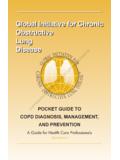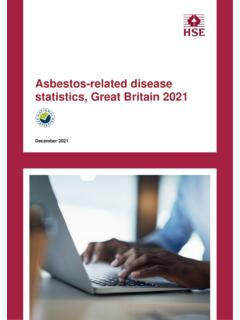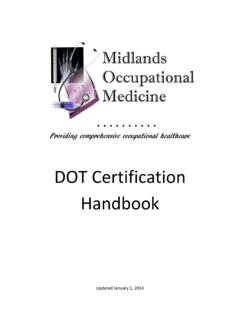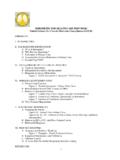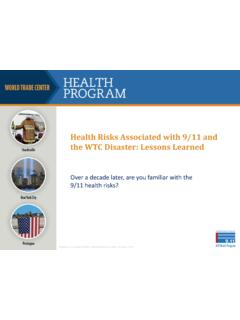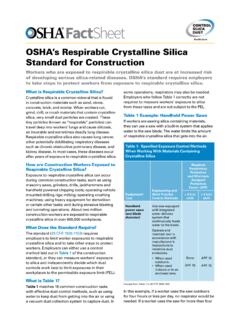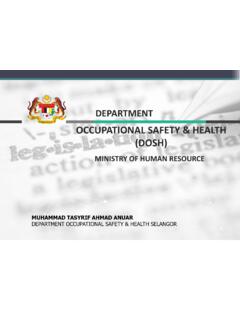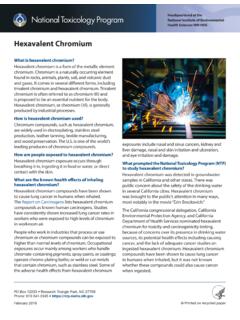Transcription of Coal Mine Dust Exposures and Associated Health Outcomes
1 CURRENT INTELLIGENCE BULLETIN 64 Coal Mine Dust Exposures and Associated Health OutcomesA Review of Information Published Since 1995 DEPARTMENT OF Health AND HUMAN SERVICES Centers for disease Control and Prevention National Institute for occupational Safety and HealthCurrent Intelligence Bulletin 64 Coal Mine Dust Exposures and Associated Health OutcomesDEPARTMENT OF Health AND HUMAN SERVICES Centers for disease Control and Prevention National Institute for occupational Safety and HealthA Review of Information Published Since 1995iiThis document is in the public domain and may be freely copied or of any company or product does not constitute endorsement by the Na-tional Institute for occupational Safety and Health (NIOSH). In addition, citations to Web sites external to NIOSH do not constitute NIOSH endorsement of the spon-soring organizations or their programs or products.
2 Furthermore, NIOSH is not responsible for the content of these Web sites. All Web addresses referenced in this document were accessible as of the publication InformationTo receive documents or other information about occupational safety and Health topics, contact NIOSH atTelephone: 1 800 CDC INFO (1 800 232 4636) TTY: 1 888 232 6348 E-mail: visit the NIOSH Web site at a monthly update on news at NIOSH, subscribe to NIOSH eNews by visiting (NIOSH) Publication No. 2011 172 April 2011 Safer Healthier PeopleTMiiiForewordSince its inception in 1970 the National Institute for occupational Safety and Health (NIOSH) has extensively investigated and assessed coal miner morbidity and mor-tality. This history of research encompasses epidemiology; medical surveillance; laboratory-based toxicology, biochemistry, physiology, and pathology; exposure assessment; disease prevention approaches; and methods development.
3 The experi-ence gained in those activities, together with knowledge from external publications and reports, was brought together in 1995 in a major NIOSH review and report of recommendations, entitled Criteria for a Recommended Standard occupational Exposure to Respirable Coal Mine Dust. This document had the following major recommendations:1. Exposures to respirable coal mine dust should be limited to 1 mg/m3 as a time-weighted average concentration for up to a 10 hour day during a 40 hour work week;2. Exposures to respirable crystalline silica should be limited to mg/m3 as a time-weighted average concentration for up to a 10 hour day during a 40 hour work week;3. The periodic medical examination for coal miners should include spirometry;4. Periodic medical examinations should include a standardized respiratory symptom questionnaire;5.
4 Surface coal miners should be added to and included in the periodic medical Current Intelligence Bulletin (CIB) updates the information on coal mine dust Exposures and Associated Health effects from 1995 to the present. A principal intent is to determine whether the 1995 recommendations remain valid in the light of the new findings, and whether they need to be updated or supplemented. The report does not deal with issues of sampling and analytical feasibility nor technical feasibil-ity in achieving Howard, MD Director, National Institute for occupational Safety and Health Centers for disease Control and PreventionivExecutive SummaryInformation relating to occupational pulmonary disease morbidity and mortality of coal miners available up to 1995 was reviewed in the NIOSH publication: Criteria for a Recommended Standard occupational Exposure to Respirable Coal Mine Dust, or Coal Criteria Document (CCD).
5 This led to the following principal conclusions concerning Health effects Associated with coal mining:1. Exposure to coal mine dust causes various pulmonary diseases, including coal workers pneumoconiosis (CWP) and chronic obstructive pulmonary disease (COPD). 2. Coal miners are also exposed to crystalline silica dust, which causes silicosis, COPD, and other These lung diseases can bring about impairment, disability and premature death. This Current Intelligence Bulletin updates the previously published review with re-spect to findings relevant to the Health of coal miners published since 1995. The main conclusions are:1. After a long period of declining CWP prevalence, recent surveillance data indicate that the prevalence is rising. 2. Coal miners are developing severe CWP at relatively young ages (<50 years).
6 3. There is some indication that early development of CWP is being manifested as premature mortality. 4. The above individuals would have been employed all of their working lives in environmental conditions mandated by the 1969 Coal Mine Health and Safety The increase in CWP occurrence appears to be concentrated in hot spots of disease mostly concentrated in the central Appalachian region of southern West Virginia, eastern Kentucky, and western The cause of this resurgence in disease is likely multifactorial. Possible expla-nations include excessive exposure due to increases in coal mine dust levels and duration of exposure (longer working hours), and increases in crystalline silica exposure (see below). As indicated by data on disease prevalence and severity, workers in smaller mines may be at special Given that the more productive seams of coal are being mined out, a transi-tion by the industry to mining thinner coal seams and those with more rock vintrusions is taking place and will likely accelerate in the future.
7 Concomitant with this is the likelihood of increased potential for exposure to crystalline silica, and Associated increased risk of silicosis, in coal main conclusions drawn from review of the new information are:1. While findings published since 1995 refine or add further to the understand-ing of the respiratory Health effects of coal mine dust described in the NIOSH CCD, they do not contradict or critically modify the primary conclusions and Associated recommendations given there. Rather, the new findings strength-en those conclusions and Overall, the evidence and logical basis for recommendations concerning prevention of occupational respiratory disease among coal miners remains essentially unaffected by the newer findings that have emerged since publica-tion of the CCD.
8 In summary, as recommended by the CCD, every effort needs to be made to reduce exposure to both coal mine dust and to crystalline silica dust. As also recommended in the CCD, the latter task requires establishing a separate compliance standard in order to provide an effective limit to exposure to crystalline silica .. iiiExecutive Summary .. ivList of Figures .. viiiList of Tables .. xAbbreviations .. xiGlossary .. xiiAcknowledgments .. xiv1 Introduction .. 12 Coal Workers Pneumoconiosis .. Surveillance .. Epidemiology .. Mortality .. Toxicology .. Risk analysis .. 213 Other Respiratory disease Outcomes .. Risk Analysis .. 244 Cancer Outcomes .. 255 Dust Exposure Levels, Control, And Compliance .. Dust Exposure Levels .. Dust Exposure Assessment .. Compliance Policy and Procedures.
9 286 Surface Coal Mining .. 297 Summary .. 318 References.. 33viiiList of FiguresFigure 1. Prevalence of CWP category 1 or greater from the NIOSH Coal Work-ers X-ray Program from 1970 1995, by tenure in coal 2. Trend in reported dust concentrations for continuous miner operators, 1968 3. Probability that an individual starting with no pneumoconiosis (cate-gory 0/0) will be classified as 2/1 or greater after 35 years of exposure to various concentrations of coal mine 4. Predicted prevalence of PMF among British coal miners after a 35-year working lifetime by mean concentration of respirable coal mine 5. Prevalence of simple CWP category 1 or greater among coal miners by estimated cumulative dust exposure and coal 6. Prercentage of evaluated miners with rapidly progressive coal workers pneumoconiosis by 7.
10 Percentage of miners in the NIOSH Coal Workers X-ray Surveillance Program with coal workers pneumoconiosis (category 1 or greater) from 1970 2009, by tenure in coal 8. Percentage of miners examined in the NIOSH Coal Workers X-ray Sur-veillance Program with progressive massive fibrosis (PMF) from 1970 2009, by tenure in 9. Observed and predicted prevalences (%) of CWP category 1 or greater by age group and MSHA 10. Hours worked per underground coal miner, 1978 11. Tons produced per hour worked at underground coal mines, 1978 12. Respirable coal mine dust: Geometric mean Exposures by type of mine (UG=underground, SU=surface), MSHA inspector (INSP) and mine operator (OPER) 13. Ratio of special inspection sample values to preceding operator compli-ance sample values by mine 14.










